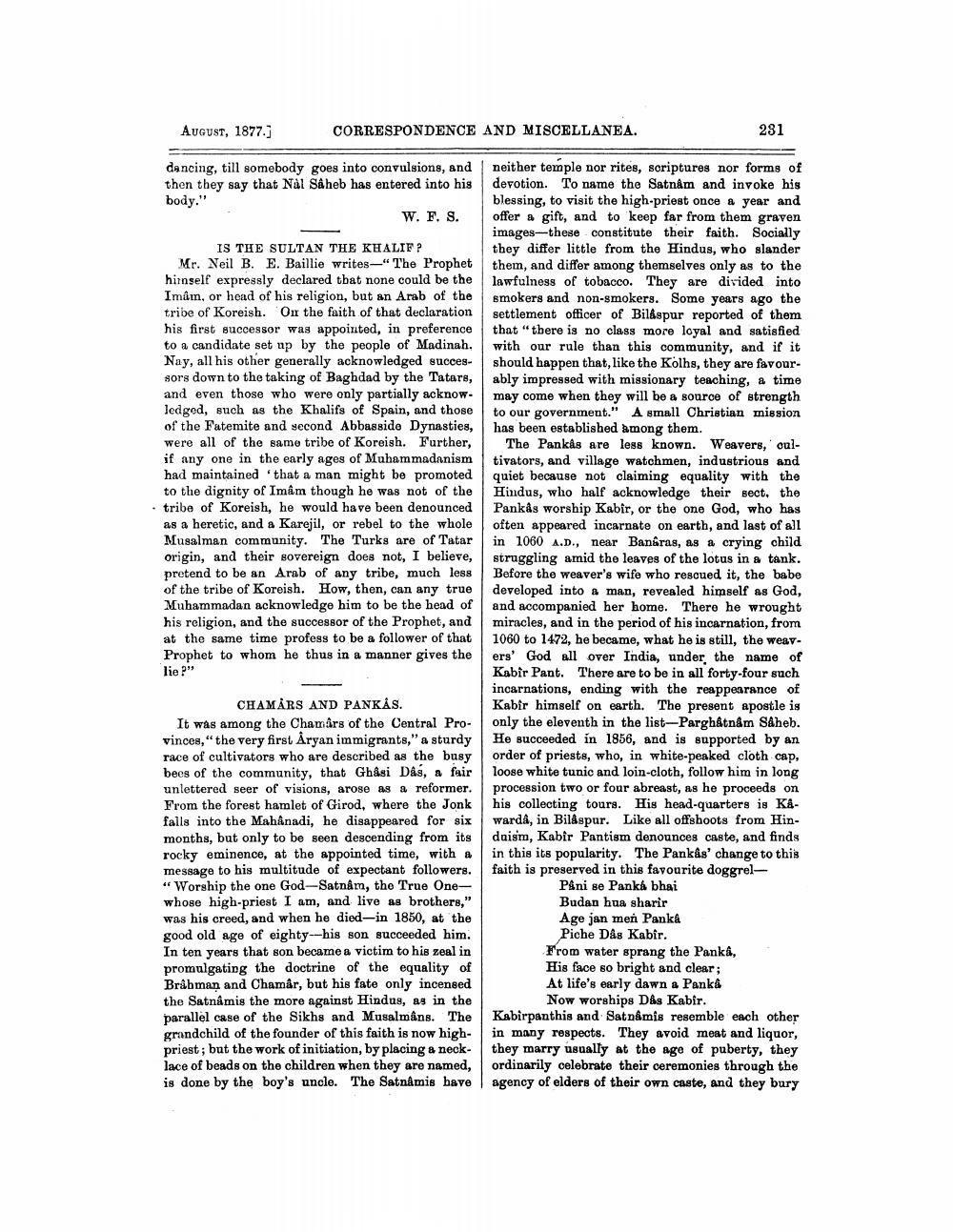________________
AUGUST, 1877.]
CORRESPONDENCE AND MISCELLANEA.
231
dancing, till somebody goes into convulsions, and then they say that Nal Saheb has entered into his body."
W. F. S.
IS THE SULTAN THE KHALIF? Mr. Neil B. E. Baillie writes-" The Prophet hirnself expressly declared that none could be the Imâm, or head of his religion, but an Arab of the tribe of Koreish. On the faith of that declaration his first successor was appointed, in preference to a candidate set up by the people of Madinah. Nay, all his other generally acknowledged successors down to the taking of Baghdad by the Tatars, and even those who were only partially acknow. ledged, such as the Khalifs of Spain, and those of the Fatemite and second Abbasside Dynasties, were all of the same tribe of Koreish. Further, if any one in the early ages of Muhammadanism had maintained that a man might be promoted to the dignity of Imâm though he was not of the tribe of Koreish, he would have been denounced as a heretic, and a Karejil, or rebel to the whole Musalman community. The Turks are of Tatar origin, and their sovereign does not, I believe, pretend to be an Arab of any tribe, much less of the tribe of Koreish. How, then, can any true Muhammadan acknowledge him to be the head of his religion, and the successor of the Prophet, and at the same time profess to be a follower of that Prophet to whom he thus in a manner gives the lie?"
neither temple nor rites, scriptures nor forms of devotion. To name the Satnam and invoke his blessing, to visit the high-priest once a year and offer a gift, and to keep far from them graven images--these constitute their faith. Socially they differ little from the Hindus, who slander them, and differ among themselves only as to the lawfulness of tobacco. They are divided into smokers and non-smokers. Some years ago the settlement officer of Bilaspur reported of them that "there is no class more loyal and satisfied with our rule than this community, and if it should happen that, like the Kolhs, they are favourably impressed with missionary teaching, a time may come when they will be a source of strength to our government." A small Christian mission has been established among them.
The Pankás are less known. Weavers,' oultivators, and village watchmen, industrious and quiet because not claiming equality with the Hindus, who half acknowledge their sect, the Pankås worship Kabir, or the one God, who has often appeared incarnate on earth, and last of all in 1060 A.D., near Banaras, as a crying child struggling amid the leaves of the lotus in a tank. Before the weaver's wife who rescued it, the babe developed into a man, revealed himself as God, and accompanied her home. There he wrought miracles, and in the period of his incarnation, from 1060 to 1472, he became, what he is still, the weavers' God all over India, under the name of Kabir Pant. There are to be in all forty-four such incarnations, ending with the reappearance of Kabir himself on earth. The present apostle is only the eleventh in the list-Parghátnám Såheb. He succeeded in 1856, and is supported by an order of priests, who, in white-peaked cloth cap, loose white tunic and loin-cloth, follow him in long procession two or four abreast, as he proceeds on his collecting tours. His head-quarters is Kåwardå, in Bilåspur. Like all offshoots from Hindaism, Kabir Pantism denounces caste, and finds in this its popularity. The Pank&s' change to this faith is preserved in this favourite doggrel -
Pâni se Panká bhai Budan hua sharir Age jan men Panka
Piche Das Kabir. From water sprang the Panka, His face so bright and clear; At life's early dawn a Panka
Now worships Dås Kabir. Kabirpanthis and Satnâmis resemble each other in many respects. They avoid meat and liquor, they marry usually at the age of puberty, they ordinarily celebrate their ceremonies through the agency of elders of their own caste, and they bury
CHAMÅRS AND PANKÅS. It was among the Chamârs of the Central Provinces," the very first Aryan immigrants," a sturdy race of cultivators who are described as the busy bees of the community, that Ghasi Dås, a fair unlettered seer of visions, arose as a reformer. From the forest hamlet of Girod, where the Jonk falls into the Mahậnadi, he disappeared for six months, but only to be seen descending from its rocky eminence, at the appointed time, with a message to his multitude of expectant followers. “Worship the one God-Satnâm, the True Onewhose high-priest I am, and live as brothers," was his creed, and when he died-in 1850, at the good old age of eighty--his son succeeded him. In ten years that son became a victim to his zeal in promulgating the doctrine of the equality of Bråbman and Chamâr, but his fate only incensed the Satnamis the more against Hindus, as in the parallel case of the Sikhs and Musalmans. The grandchild of the founder of this faith is now highpriest; but the work of initiation, by placing a necklace of beads on the children when they are named, is done by the boy's uncle. The Satnamis bave




